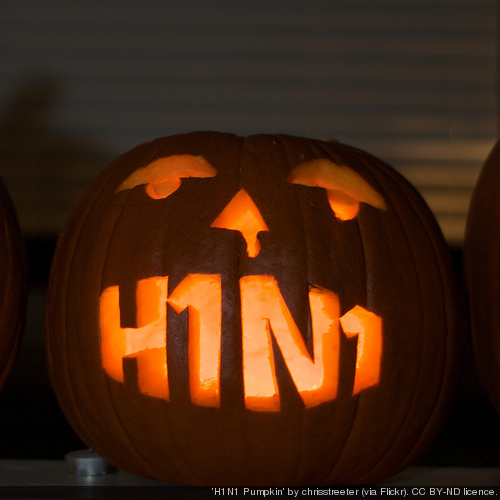Monica Mula
Web Opinions Editor
 As cold weather approaches before the flu season officially begins, rumors of the spread of H1N1 are more rampant than the flu itself.
As cold weather approaches before the flu season officially begins, rumors of the spread of H1N1 are more rampant than the flu itself.
While students estimate that up to 300 people have been absent in a single day, Nurse Alicia Casucci proves otherwise.
“The absentee rate has fluctuated about 10%,” said Casucci. “However, the district mandate is that over 50% of students must be ill with H1N1 before the schools can close.”
Attendance Secretary Patricia McQuone noticed a similar gradual increase in the number of students missing school.
Though not all students and parents state their reason when calling in an absence, McQuone will often inquire if the student is experiencing flu-like symptoms.
“When I’m getting 2-3 calls at a time, it is difficult to discuss for very long,” said McQuone. “But I do try to get a sense of whether or not the illness is H1N1, so that I can refer them to the nurses.”
McQuone and Casucci both stress the fact that the nurses must be notified of every case of swine in order to accurately track the number of cases of H1N1 in the district.
Though reporting H1N1 has not been problematic as of yet, recognizing symptoms and remaining home when ill has been a struggle for many.
Despite the strict guidelines outlined on page 91 of the Staples Handbook, students still drag themselves to school with coughs, aches, and fevers.
Casucci recommends referring to this page when in doubt.
“The individual must have a temperature lower than 100 degrees for 24 hours, without the influence of medication,” said Casucci.
Many are under the impression that use of pain-killers such as Tylenol, Motrin, and Ibuprofen is a way to lower fevers. While they may be useful, students must take their temperatures when they are unaffected by drugs.
“We can’t patrol the entrances for sick kids each day,” said Casucci.
This leaves the responsibility in the hands of students.
As Principal John Dodig noted in his Nov. 16 e-mail, students must be courteous of their teachers and peers.
“It is best to keep a child home when sick rather than sending her/him to school to possibly infect other children. With H1N1 it is now even more important than ever to abide by this guideline,” said Dodig.
The problem seems to root in the determination of students. Many fear falling behind, even after a one-day absence.
Emily Jennings ’10 recently battled both pneumonia and H1N1 in a close timeframe, warranting 10 days of absence.
As a senior, fall is a particularly busy time to be so sedentary, yet Jennings stayed in contact with her teachers throughout her leave.
“Most of my teachers were very understanding and gave me ample time to turn in make-up work. Being that it was approaching the end of the quarter, however, I felt pressured to get my work in on time so as not to get ‘Incompletes’ on my report card,” said Jennings.
Still waiting on test results for Mononucleosis and Lyme’s Disease, Jennings has been back at school. She was careful to wait until she was no longer contagious.
Spanish teacher Senora Cuevas de Taranto similarly made sure she was fully healthy before returning after her bout with H1N1.
“I came back to school after a week of absence, and under the advice of my doctor and the school nurses. Although I was feeling better, I waited the appropriate amount of time,” said Cuevas de Taranto.
Having suffered H1N1 and a lingering cough, Cuevas de Taranto is sympathetic of students in her classes who are absent.
“I understand what it is like to not have the stamina to do anything,” she explains. “I advise my students to check blackboard for updates and meet with me upon their return.”
Cuevas de Taranto also made certain that the substitutes carried out meaningful lesson plans that related to the given unit so that they could progress even in her absence.
Caley Beretta ’10 can relate to teachers like Cuevas de Taranto. She has had to take on impromptu leadership roles because of the spread of illness throughout Staples Players.
“Players work in such a close environment— not only are we sharing props and costumes, but every cast, tech, and pit member has been at rehearsal from 2:30 to 9 this last week. The level of exhaustion surely does not help our immune systems,” said Beretta.
Beretta has taken an immense leadership role as Director upon David Roth’s absence, yet remains optimistic, and all three shows will be performed as scheduled.
The caliber of Staples makes the spread of illness inevitable— scholars, athletes, actors, and musicians alike are eager to keep up with their commitments.
Fear of facing the Court of Appeals seems to be merely an excuse for attending school sick, for, as Dodig explained, a doctor’s note will prevent sick students from being penalized.
“It only becomes a problem when unexcused absences add up and the student then becomes legitimately ill,” said McQuone. “Because of their own irresponsibility in the first place, they will still face credit loss.”
Students and faculty must take precaution before returning to school after H1N1, or any contagious illness.
If everyone acts with integrity by reporting H1N1 cases and not taking irresponsible days off, there would not be a problem whatsoever with the Court of Appeals policy.
Teachers must communicate through Blackboard or e-mail with absent students, and students must prove equally as mature by checking and responding. If this balance can be achieved, sick kids might stay home, thus decreasing the risk of spread of H1N1.













































